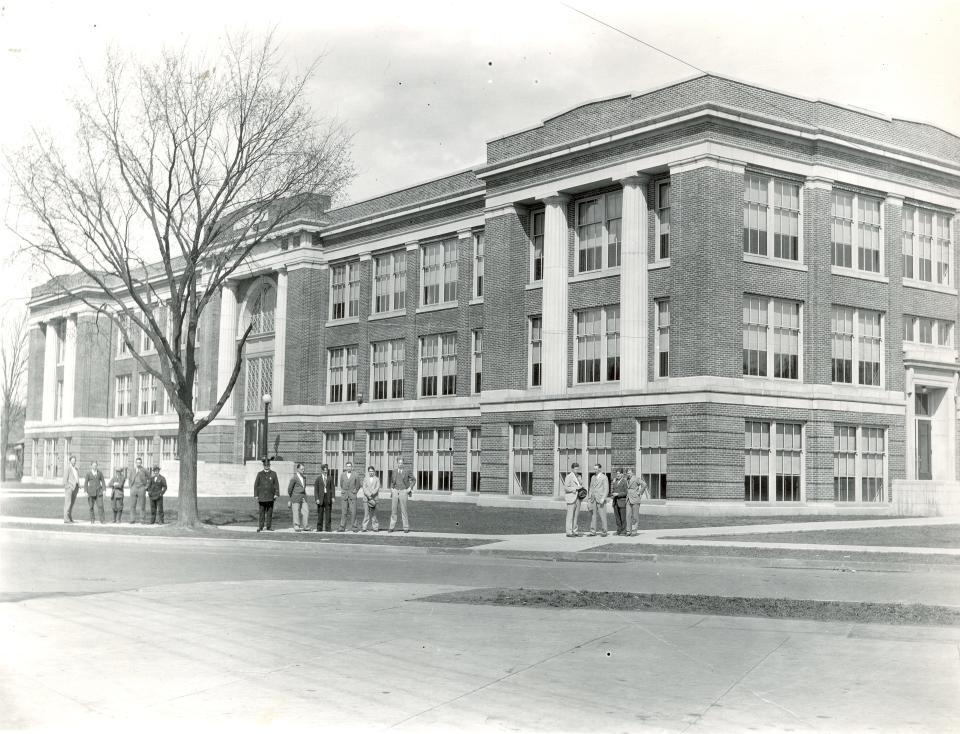Elmira's first Southside High School was spurred by overpopulation, marked by controversy
“On the morning of Jan. 28, 1924 the first faculty and the first student body entered the new Southside High School for the first time.”
It was an exciting but anxious day for those new arrivals. Students going to school had to provide their own transportation. One dedicated student recalled that first day in the “Golden Anniversary” edition of the Edsonian in 1974. Noting that the streetcar line ended at the junction of Southport St. and Pennsylvania Ave., she told of her journey to school.
“On that cold snow-on-the-ground morning … having given myself more time than I needed to walk the one and a half mile from my home on Christian Hollow to the end of the car line I waited for the streetcar …” Asked if I was nervous, “I was nothing but petrified (having never been in a ‘city school’ before) but … since the school was just opening, no one else would know where to go or what to do either.”
The school did not open without controversy. According to an article in the Jan. 10, 1926 Star Gazette, “when the cafeteria first went into operation a furor of protest followed in its wake. Stories circulated that lunch cost 75 cents. Appealing pictures of the poor boy who must go to school but who cannot afford such extravagance were portrayed. The community rose up in arms and an ordinance was threatened from the Common Council prohibiting the cafeteria from opening …” The article noted that when the facts came out the average cost for a tray of food was 15 cents.
Oh, how times have changed.

In November of 1923 it was reported that more than 7,000 girls and boys attended Elmira’s public schools with a projected increase of 300 for 1924. For the 2023-24 school year the estimated number is 5,429.
In 1921, a plan was put forth to not only build a new Southside High School but a new Northside School. Superintendent H.O. Hutchinson presented that “the new junior-senior high school of the Southside to be immediately erected and accommodate 1,000 students; later a second junior-senior high school on the Northside, located on the Arnot property at Park Place and Clinton Street (present site of LECOM) shall be built.” (Star Gazette Dec. 14, 1921)
The necessity for a new school was made clear by the report that the “Elmira Free Academy sat 900 students comfortably with at that point nearly 1,400 students in attendance. It was reported that 100 to 200 were studying every single period of the day in the auditorium with books and materials on their knees instead of a regulation school desk.” (Star Gazette Oct. 26, 1921)
At that time the concept of a junior-senior high school was relatively new. Apparently Rochester and Syracuse were the only two other cities in New York State with one. Superintendent Hutchinson visited the Syracuse junior-senior high school prior to preparing his plan. According to his plan $1 million would be needed for construction, $500,000 for each of the newly proposed schools. The architects Pierce and Bickford would design the new Southside High School.
The debate over funding was intense. On Dec. 28, 1921 the Star Gazette opined, “Elmira is going to grow — and one sure way to make it grow is to build big modern schools … A few extra thousand dollars will make the Southside school the best of its kind … Future generations certainly can not object to paying for some of the buildings, parks, pavements and other betterments now contemplated.”
NY Databases: Restaurant inspections, real estate sales and more at stargazette.com
The Taxpayers Association objecting to the project pointed out that “30 percent of our wage earners are out of employment and 2,000 children, using the words of the Christmas report of the Arctic League, are living in conditions of unbelievable want and misery … What is a million and a quarter of dollars (based on borrowing with interest)? It’s the average annual income for a first class union carpenter for 1,400 years.” (Star Gazette Feb 27, 1922).
Ground was broken for the new high school in August 1922. The total cost of its building, not including site or equipment, was $520,376.85. The Felton Construction Company of Buffalo built the school. At the time of its opening work had not been completed.
An unusual feature of the new school was the “practice house” for the girls of the home economics department located across from the rear of the new building on Powell St. The house was one of several purchased when the school plot was acquired. Students lived there for specified periods to gain practical experience in the homemaking arts. It was phased out in the 1950’s.
Booth School apartments: What to know about project, developer and more
Mr. Frank M. Edson was chosen to be the new principal. He had been principal of School No. 11, the former Hoffman School. Thomas J. McCarthy, in the March 1974 Chemung Historical Journal, wrote that, “The spirit and traditions which were developed in the early years at Southside High can be traced largely to the ideals of Mr. Edson … a dedicated educator and administrator.” Mr. Edson died at the age of 58 on Nov. 28, 1932. The school yearbook was renamed the Edsonian in Edson’s honor starting with the 1935 issue.
The original Southside High School closed at the end of the 1978-79 school year. In the Fall of 1979 the new Southside High School opened. That school is now the Elmira High School. The old building is now a county office building. The yearbook for Elmira High School is entitled “Expressions.”
— Jim Hare writes a monthly history column.
This article originally appeared on The Evening Tribune: Elmira's original Southside High School was built with future in mind

